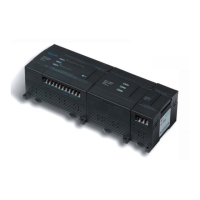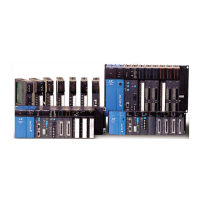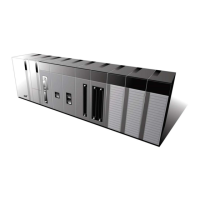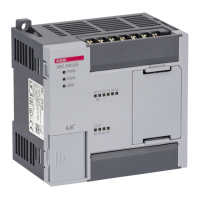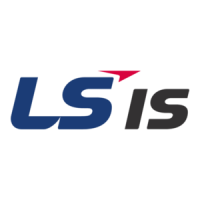
Do you have a question about the LS Industrial Systems GLOFA G7M-DR20U/DC and is the answer not in the manual?
| Input Points | 12 |
|---|---|
| Input Type | DC |
| Output Points | 8 |
| Output Type | Relay |
| Power Supply | 24V DC |
| Operating Temperature | 0°C to 55°C |
| Storage Temperature | -25°C to 70°C |
| Manufacturer | LS Industrial Systems |
| Model | G7M-DR20U/DC |
| Communication Ports | RS-232 |
| Humidity | 5% to 95% (non-condensing) |
| Dimensions | 90mm x 90mm |
Guidelines for safe system design to prevent errors and damage.
Precautions to take during the physical installation of the PLC.
Essential safety measures for electrical wiring connections.
Safety measures for initial startup and ongoing maintenance.
Guidelines for safe and environmentally sound disposal of the product.
Explains manual structure, specifications, functions, and handling instructions.
Details the features and advantages of the GLOFA-GM7U series.
Defines key terms used throughout the manual for clarity.
Describes the basic, computer link, and network system configurations.
Lists and describes the functional model of the GLOFA-GM7U series.
Provides detailed specifications for environmental, electrical, and mechanical properties.
Identifies and describes the components of the main PLC unit.
Details the various expansion modules available for the PLC system.
Describes the Analog/Digital conversion and Analog timer modules.
Details AC and DC power supply specifications, including voltage and current ratings.
Outlines the specifications for the CPU, including memory, I/O points, and instruction set.
Explains scan time, watchdog timer, timer, and counter processing.
Covers program configuration, execution procedures, task programs, and error handling.
Describes the RUN, STOP, PAUSE, and DEBUG operation modes.
Explains restart modes, self-diagnosis, remote functions, and I/O force functions.
Details the program and data memory configurations and capacities.
Explains how I/O numbers are allocated to modules for addressing.
Describes the structure and usage of the built-in communication setting switch.
Explains the structure and usage of the external memory module for program saving.
Details the specifications, structure, and usage of the Real Time Clock option module.
Provides general specifications for digital inputs and outputs, including relay output life.
Outlines specifications for main unit digital inputs, including points, voltage, and impedance.
Covers specifications for main unit relay, NPN TR, and PNP TR outputs.
Details specifications for expansion modules with relay output, including points and life.
Details specifications for expansion modules with TR output, including points and current.
Explains built-in functions like High Speed Counter, Pulse Catch, Input Filter, and PID Control.
Details performance specifications for A/D, D/A, Analog Timer, and RTD input modules.
Covers specifications, control methods, operation patterns, and instructions for positioning.
Introduces and explains the built-in Cnet communication for GM7U main units.
Describes how to define and use custom communication protocols for GM7U.
Details Modbus ASCII and RTU modes, specifications, and addressing rules.
Explains how to send/receive unfixed data using custom frame designations.
Covers remote connection via Cnet I/F, modem, and Fnet I/F modules.
Details installation environment requirements and precautions, including heat protection.
Provides instructions for power supply, input/output device, and grounding wiring.
Explains grounding methods for noise protection and reliability.
Lists recommended cable specifications for various external connections.
Covers periodic inspection items for ambient environment and module conditions.
Lists daily inspection items, including LED status and terminal conditions.
Details items for periodic inspection (every six months) and corrective actions.
Provides a systematic approach to identifying and resolving issues.
Offers flowcharts for common issues like power, error LEDs, and I/O operation.
A questionnaire to gather details about problems for service center contact.
Provides examples of common input and output circuit troubles and their fixes.
Lists error codes, causes, corrective actions, and operation status.
Explains connection options and communication parameter settings in GMWIN.
Describes how to set directories for GMWIN files.
Details options for monitoring variables and debugging LD programs.
Explains project make options, including compile type and clearing M area.
Covers PLC name, communication control, restart mode, and CPU properties.
Details communication parameters like station no., baud rate, and parity bit.
Outlines PID and Position parameters for modules.
Details parameters for PID auto-tuning and PID control settings.
Explains parameters for acceleration, deceleration, origin return, and JOG speed.
Details parameters for High Speed Counter formats, modes, and functions.
Lists and describes user-defined flags for operation status and errors.
Details system error flags for module, I/O, communication, and device errors.
Lists system warning flags for continuous operation, RTC, battery, and communication errors.
Provides detailed system error and warning flags with their meanings.
Lists flags related to CPU type, O/S version, memory type, and PLC mode.
Describes flags for system S/W configuration, basic parameter, program, and communication errors.
Details flags indicating the state of the operation mode change switch.
Lists available functions with their size, library usage, and processing speed.
Lists available function blocks with their size, library usage, and processing speed.
Provides external dimensions for the base unit in millimeters.
Provides external dimensions for standard type extension modules in millimeters.




